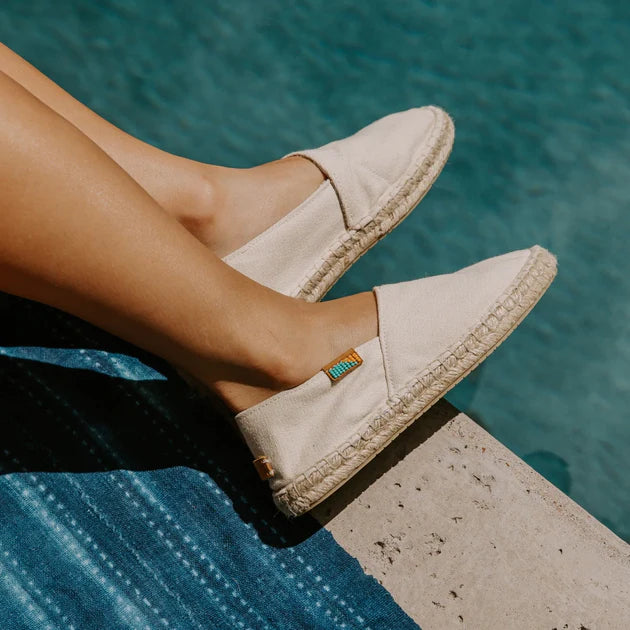
Share this Article
The shoe of the summer: How it’s made and how it came to be.

How It Started
Early in the morning as Ubuntu Life co-founder Zane Wilemon boarded a plane for Ethiopia, the thought crossed his mind that he’d never be able to make a shoe.
“I was handicapped by fear that it was all nothing more than a big idea. And yet here we were, Jeremiah Kuria, our Ubuntu Life Co-founder, and five very adventurous executives from Zazzle, a Silicon Valley-based company, flying from Nairobi to Addis Ababa on a quest to master the art of shoemaking.”
The goal was to learn how to make shoes and then bring the concept back to our Ubuntu Life Maker Mums, and empower them to make shoes. But not just any shoe would do – this was going to be Africa’s first fully customizable shoe.
As much as Zane believed in our Ubuntu Life Maker Mums, the reality was that not a single one of us had ever made a shoe, worked for a company that made shoes nor had any affinity for a career in cobbling. Regardless, they were boarding a plane for Ethiopia to learn about the shoe-making process, carrying a heavy burden of doubt wondering if they could truly pull this off.
As the Ethiopia journey drew to a close, Zane and his team soon came to the realization that they were probably trying to pull off too much of a feat by making shoes in Kenya. The expertise required, the vulcanization process of making soles alone and all the extra equipment they would need to purchase made this once exciting endeavor a roaring and humbling defeat within just a few days. They packed our bags and headed back to Nairobi, our Zazzle crew leaving for the US just days later.
Months went by and the feeling of embarrassment lingered. But then Zane received an email from the Zazzle team. The email was brief, “Hey Zane check out this YouTube clip of a woman homemaking an espadrille shoe. Looks simple, like she took two of our canvas coffee sleeves, sewed them together and attached a jute sole. Think the Maker Mums could pull this off if we‘re able to locate a sole manufacturer?”
And then just like that, everything changed! A year of blood, sweat, love and tears later, the team made Kenya’s first espadrille shoe and Africa’s first fully customizable shoe which they affectionately branded, The Afridrille.

Each season we bring you brand new colors and styles of Afridrilles. Made from 100% East African cotton traditionally milled in Kenya and then screen printed with eco-friendly inks, our shoes are made by hand in our Maker Studio in Maai Mahiu.
What makes our Afridrilles particularly special is the amount of care that goes into each pair, and the number of skilled makers involved in the artisanal process. Afridrille season is officially upon us, and to mark the occasion, we are proud to share the multi-stage Afridrille maker journey.
These are the steps that go into making each Afridrille collection.
One Pair of Shoes | 11 Pairs of Hands.
Step 1: The naturally white canvas is screen printed by hand.
Step 2: Once printed, we use our custom card stencils to outline in pen the shape of the four separate pieces of cotton canvas that make up the Afridrille, known in the shoe business as the 'uppers.'

Step 3: We outline the same-sized pieces in our custom patterned material that we use as the inside lining.
Step 4: Next, we apply a piece of reinforcement material to the back of the cup-shaped pieces of canvas and lining, using an iron's heat to adhere them. Each piece is then trimmed to ensure that they are the exact same shape.

Step 5: A Maker Mum sews the longer pieces of fabric together to create a pocket where reinforcing material can be placed inside. With the reinforcement material comfortably tucked into the pocket, we put the shoe in our heat press to bind together.
Step 6: With the reinforcement material heat pressed into place and the lining and canvas materials adhered, the four pieces that make up the upper part of the shoe go back to a Maker Mum where the pieces are sewn together.

Part of this step includes incorporating the Ubuntu Life beaded tab, which our Maasai Maker Mums have made near Kenya's Ngong Hills.

Step 7: The two pieces, which each make up a shoe, go back to the ironing section for another heat press. We use ironing and a heat press to ensure the canvas pieces have perfectly adhered to at every step.
Step 8: The two parts that make up each shoe's uppers go for the first of many quality control checks. At this point, we look to see if the uppers still match up with the cardboard stencils we use to measure the Afridrilles.
Step 9: If the work meets the quality control, the two parts go to another Maker Mum at a sewing machine who inserts a small piece of black elastic that gives our Afridrilles a bit of give, making them extra comfy. It's at this stage where the shoes really start to take shape.

Step 10: Here we do our second quality check. The checks increase in frequency from this stage on.
Step 11: As the upper parts of the shoe are being measured, cut, and sewn, tan leather is being cut using a cookie-cutter metal plate.
Step 12: Once the tan leather sole is cut to shape, the Ubuntu Life logo symbolizing the notion of 'Ubuntu' is heat-pressed at 93°F onto the leather.

Step 13: The embossed leather sole is now glued atop a traditional jute espadrille sole.

Step 14: At this point, the uppers and the sole come together. The canvas is carefully lined up to the sole and held in place by colorful sewing pins as it is hand-sewn with jute twine.

Step 15: At this final step, the Ubuntu label is sewn onto the back of the shoe.

Now complete, the shoe goes through a rigorous final check. If the shoes pass muster, a piece of card is tucked into each shoe to keep its shape as it travels across the Atlantic to you.

